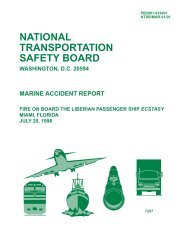as predicted, s<strong>in</strong>gle deliveries haveshown exceed<strong>in</strong>gs of the normal data,as a result of a more efficient ref<strong>in</strong>eryprocess. The residual fuel oils availableon the market today conta<strong>in</strong> considerablyhigher quantities of asphalt, carbon<strong>and</strong> sulphur that contam<strong>in</strong>ate the exhaustgas <strong>and</strong> thereby <strong>in</strong>crease the riskof soot deposits on the exhaust gasboiler tubes.In recent years, <strong>and</strong> possibly as a consequenceof both the deteriorated fuel<strong>and</strong> the above highly efficient <strong>and</strong> perhaps“overstretched” design, it also seemsthat the tendency to foul<strong>in</strong>g, i.e. sootdeposits on the exhaust gas boiler tubes,has <strong>in</strong>creased <strong>and</strong>, <strong>in</strong> some cases, hasresulted <strong>in</strong> soot fires. In extreme cases,the soot fire has developed <strong>in</strong>to a hightemperature iron fire <strong>in</strong> which the boileritself burns. The above-mentioned tendencyis confirmed by DnV’s statistics,which reveal a sudden rise <strong>in</strong> soot fire<strong>in</strong>cidents s<strong>in</strong>ce 1985, see Fig. 1 <strong>and</strong>Ref. [1], a rise, which may also havebeen caused by slow steam<strong>in</strong>g of shipsdue to the low freight rates <strong>in</strong> recentyears.S<strong>in</strong>ce 1998, we have aga<strong>in</strong> seen a fall<strong>in</strong> the number of <strong>in</strong>cidents, probablycaused by the effect of the new recommendedexhaust gas boiler design criteria<strong>in</strong>troduced about 10 years ago, <strong>and</strong>described <strong>in</strong> this paper.It is evident that the high fuel efficiencytarget must be met without jeopardis<strong>in</strong>gthe reliability of the ship. It is thereforeimportant to know the ma<strong>in</strong> reasons forthe occurrence of soot deposits <strong>and</strong>fires so we can take the proper countermeasuresaga<strong>in</strong>st them with a correctexhaust gas boiler/system design, etc.Warn<strong>in</strong>g triangle –risk of soot fireIgnition(of the soot)Fig. 2: Warn<strong>in</strong>g triangle - risk of soot fireWhen soot fires occur, the diesel eng<strong>in</strong>ewill normally be blamed s<strong>in</strong>ce the sootparticles <strong>in</strong> fact orig<strong>in</strong>ate from the eng<strong>in</strong>e’sfuel combustion. As, <strong>in</strong> pr<strong>in</strong>ciple, particles<strong>in</strong> the exhaust gases are unavoidablefrom a modern diesel eng<strong>in</strong>e runn<strong>in</strong>g onheavy fuel Ref. [1], the causes of soot deposits/firesmay be approached by ask<strong>in</strong>ga different question: What makes thesoot particles deposit <strong>and</strong>/or whatcauses the ignition of the soot deposits?This question may be illustrated by the“warn<strong>in</strong>g triangle” <strong>in</strong> Fig. 2 show<strong>in</strong>g thethree factors which are all needed for asoot fire: soot deposits, oxygen <strong>and</strong> ignition.As the exhaust gas smoke from adiesel eng<strong>in</strong>e, due to its high air excessratio, conta<strong>in</strong>s about 14% oxygen, thesoot deposits <strong>and</strong> ignition items are ofparticular <strong>in</strong>terest, as the oxygen cannotbe removed.Oxygen O 2(<strong>in</strong> exhaust gas smoke)<strong>Soot</strong> deposits(on boiler tubes)Scope of this paperThis paper is divided <strong>in</strong>to two chapterswhich, <strong>in</strong> pr<strong>in</strong>ciple, may be consideredas two separate papers.The <strong>in</strong>tention with Chapter I is to give aquick <strong>in</strong>troduction to the most commonly-usedexhaust gas boiler types,steam systems <strong>and</strong> relevant parameters.Read<strong>in</strong>g this chapter will form agood <strong>in</strong>troduction before proceed<strong>in</strong>g tothe issues of pr<strong>in</strong>ciple discussed <strong>in</strong>Chapter II.Chapter II deals with the essential conditionscaus<strong>in</strong>g soot deposits <strong>and</strong> fires<strong>in</strong> exhaust gas boilers. The reasons forsoot deposits <strong>and</strong> their ignition are identifiedon the basis of statistical materialetc. In this context, recommendationsare given which are relevant to the design<strong>and</strong> operation of exhaust gas systems<strong>and</strong> boilers.4This document, <strong>and</strong> more, is available for download at Mart<strong>in</strong>'s Mar<strong>in</strong>e Eng<strong>in</strong>eer<strong>in</strong>g Page - www.dieselduck.net
Chapter IBasic Information <strong>and</strong><strong>Boiler</strong> Def<strong>in</strong>itionsHeat balance of a ma<strong>in</strong> eng<strong>in</strong>eWhen consider<strong>in</strong>g a heat balance diagramwhich, by way of example, is shown <strong>in</strong>Fig. 3 for a nom<strong>in</strong>ally rated highly efficienteng<strong>in</strong>e version 6S60MC-C (or 6S60ME-C),operat<strong>in</strong>g on 80% SMCR (80% of specifiedmaximum cont<strong>in</strong>uous rat<strong>in</strong>g), the mostattractive waste heat source is the exhaustgas heat. Approximately one fourth ofthe fuel energy comes out as exhaustgas heat.Even though the exhaust gas temperaturethe last 25 years has decreased about130°C, from approx. 375°C to approx.245°C (ISO), as a result of the obta<strong>in</strong>edhigher efficiency of diesel eng<strong>in</strong>es, exhaustgas boilers are <strong>in</strong>stalled on almost allmerchant ships of today. However, thisdevelopment has been accompaniedby more trouble, as mentioned before.Permissible exhaust gasback-pressureThe permissible gas pressure loss acrossthe exhaust gas boiler has an important<strong>in</strong>fluence on the gas velocity through theboiler. Thus, if a high pressure loss isacceptable, it is possible to design theboiler with a high gas velocity, but if onlya small pressure loss is permissible, thegas velocity will be low.The permissible pressure loss across theboiler depends on the pressure lossesof the total exhaust gas system after thediesel eng<strong>in</strong>e’s turbocharger(s).Permissible back-pressure of exhaustgas system for MC/MC-C <strong>and</strong>ME/ME-C eng<strong>in</strong>esAt the specified MCR of the eng<strong>in</strong>e, thetotal back-pressure <strong>in</strong> the exhaust gassystem after the turbocharger, <strong>in</strong>dicatedby the static pressure measuredas the wall pressure <strong>in</strong> the circular pipeafter the turbocharger, must not exceed350 mm WC (0.035 bar), see Fig. 4.In order to have a back-pressure marg<strong>in</strong>for the f<strong>in</strong>al system, it is recommendedat the design stage that about 300 mmWC (0.030 bar) at specified MCR isused <strong>in</strong>itially.The back-pressure <strong>in</strong> the exhaust gassystem depends on the gas velocity,i.e. it is proportional to the square of theexhaust gas velocity, <strong>and</strong> hence to the pipe6S60MC-CSMCR: 13,560 kW <strong>and</strong> 105.0 r/m<strong>in</strong>Service po<strong>in</strong>t: 80% SMCRFuel100%Shaft poweroutput 50.5%Lubricat<strong>in</strong>goil cooler3.3%Jacket watercooler5.8%<strong>Exhaust</strong> gas25.0%Air cooler14.6%Heat radiation0.8%∆∆∆p system∆p 1p 2p 3Max p 350 mm W.C.Design p 300 mm W.C.Sparkarrester<strong>Exhaust</strong>gassilencer∆∆system
















